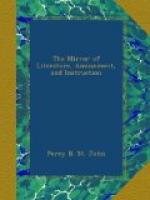* * * * *
WOLVES OF NORTH AMERICA.
(From Featherstonehaugh’s Journal.)
Wolves are very numerous in every part of the state. There are two kinds: the common or black wolf, and the prairie wolf. The former is a large, fierce animal, and very destructive to sheep, pigs, calves, poultry, and even young colts. They hunt in large packs, and after using every stratagem to circumvent their prey, attack it with remarkable ferocity. Like the Indian, they always endeavour to surprise their victim, and strike the mortal blow without exposing themselves to danger. They seldom attack man except when asleep or wounded. The largest animals, when wounded, entangled, or otherwise disabled, become their prey, but in general they only attack such as are incapable of resistance. They have been known to lie in wait upon the bank of a stream, which the buffaloes were in the habit of crossing, and, when one of those unwieldy animals was so unfortunate as to sink in the mire, spring suddenly upon it and worry it to death, while thus disabled from resistance. Their most common prey is the deer, which they hunt regularly; but all defenceless animals are alike acceptable to their ravenous appetites. When tempted by hunger, they approach the farm-houses in the night, and snatch their prey from under the very eye of the farmer; and when the latter is absent with his dogs, the wolf is sometimes seen by the females lurking about in mid-day, as if aware of the unprotected state of the family. Our heroic females have sometimes shot them under such circumstances. The smell of burning assafoetida has a remarkable effect upon this animal. If a fire be made in the woods,




